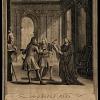IV.5 The method for debating questions: the disputation
External links
Commentary
A chamber for disputation.
Image 1. Loggan, Oxonia illustrata (1675), plate VI.
Commentary. This engraving reveals the seventeenth-century arrangement of the wooden furnishing for the purpose of academic disputation. To the left and right are two lecterns, still preserved today: one for the proponens, who presented and defended the theses being debated; the other for the respondens, who attempted to refute the arguments proposed and to defend the opposite case. Each is placed on its own elevated dais, to allow auditors, who stand rather than sit during the disputation, to see and hear the speakers. Between them, on a still higher dais, sat the praeces, who moderated the proceedings. The disputants were separated from the auditors by a gated balustrade.
Image 2. Engraving by F. C. Lewis (1813) from a watercolour by Grederick Mackenzie in Rudolph Ackermann, History of the University of Oxford, its Colleges, Halls, and Public Buildings I1814).
Commentary. This engraving depicts a divinity 'degree exercise' or disputation in progress at a time when this this medieval practice, already half a millennium old, no longer attracted large crowds. The dais has been reduced to something like its current width, but the lecterns have been raised still higher. The gated balustrade and the moderator's central pulpit were subsequently removed. Current views of this room and a 3 D panorama are available here.
Credit: Howard Hotson (September 2016)

